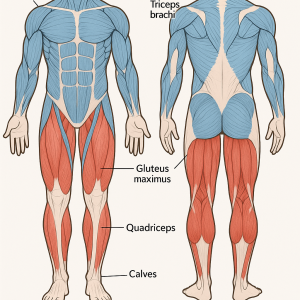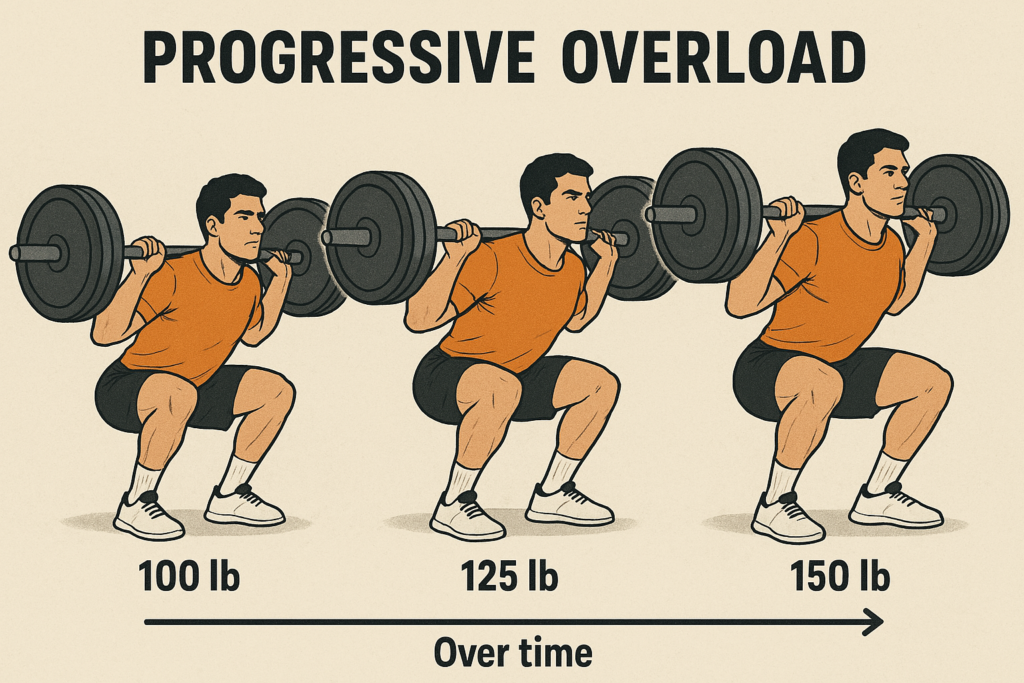
Did you know that training each muscle group twice per week can lead to up to 38% more muscle growth compared to once-weekly training? That’s what makes upper/lower splits so incredibly effective! I’ve been programming strength routines for over 15 years, and I’ve consistently seen better results with properly designed upper/lower splits than almost any other training approach.
Upper/lower splits have exploded in popularity over the past few years, and for good reason. They provide the perfect balance between training stimulus and recovery that so many programs miss. Back when I first started lifting, I was doing the classic “chest on Monday, back on Tuesday” bro split, and my progress was frustratingly slow. It wasn’t until I switched to an upper/lower approach that I really started seeing consistent strength gains.
In this guide, I’ll walk you through everything you need to know about setting up an effective upper/lower split that will maximize your strength gains while ensuring proper recovery. You’ll learn how to structure your training week, select the right exercises, apply progressive overload principles, and optimize recovery between sessions. By the end, you’ll have all the tools you need to design a program that works for your specific goals and experience level.
Let’s dive in and unlock the full potential of this incredibly effective training approach!
What Is an Upper/Lower Split and Why Is It Effective?
An upper/lower split is exactly what it sounds like – you divide your training into sessions that focus on either upper body or lower body muscle groups. On upper body days, you’ll train chest, back, shoulders, and arms. On lower body days, you’ll work your quads, hamstrings, glutes, calves, and typically abs as well.
I remember when I was stuck following a traditional body part split (you know, the “International Chest Day” on Monday approach), and man, was I spinning my wheels! The problem? I was only hitting each muscle group once every 7 days. Research consistently shows that for natural lifters, training muscles more frequently – specifically 2-3 times per week – provides optimal stimulus for growth.
What makes the upper/lower approach so effective compared to other splits? It’s all about that training frequency sweet spot. When you train a muscle, protein synthesis (the process of building new muscle) remains elevated for about 24-48 hours. With once-per-week training, you’re leaving a lot of potential growth on the table! But with an upper/lower split, you’re typically hitting each muscle group twice weekly, which keeps that growth signal more consistently activated.
Another huge benefit is recovery management. I learned this lesson the hard way when I tried a high-frequency full-body approach that had me squatting three times per week. My performance tanked by the third session because I simply wasn’t recovered enough. The beauty of upper/lower splits is that while your upper body is working hard, your lower body is recovering, and vice versa. This creates a beautiful balance that allows for high-quality training sessions.
The upper/lower approach works exceptionally well for several types of lifters:
- Intermediates who have outgrown full-body routines
- Busy individuals who can only train 4 days per week
- Those who want a good balance of strength and hypertrophy
- Lifters who respond better to higher frequency but need adequate recovery
Don’t get me wrong – other splits like Push/Pull/Legs (PPL) can be effective too. But in my experience, PPL often becomes a 6-day approach that can lead to recovery issues for many natural lifters. The upper/lower model just seems to hit that sweet spot of stimulus and recovery for most people.

Designing Your Upper/Lower Split: 4-Day vs. 5-Day vs. 6-Day Options
When I first switched to an upper/lower split, I jumped straight into a 6-day program because… well, more is better, right? Boy, was I wrong! I burned out after three weeks and actually lost strength. The lesson? Choose the right frequency for your experience level and recovery capacity.
The most common and probably most effective approach for most lifters is the 4-day upper/lower split. Here’s how it typically looks:
- Monday: Upper Body A
- Tuesday: Lower Body A
- Wednesday: Rest
- Thursday: Upper Body B
- Friday: Lower Body B
- Saturday/Sunday: Rest
This structure gives you two upper and two lower sessions each week, with adequate recovery between similar workout types. That mid-week rest day is crucial! I’ve found it helps prevent the cumulative fatigue that can build up by the end of the week.
For those who want a bit more training volume, a 5-day approach can work well:
- Monday: Upper Body A
- Tuesday: Lower Body A
- Wednesday: Rest
- Thursday: Upper Body B
- Friday: Lower Body B
- Saturday: Upper Body C (lighter/specialized)
- Sunday: Rest
The key with the 5-day approach is making that fifth day less demanding – perhaps focusing on smaller muscle groups or using lighter loads to avoid overtraining. I’ve had clients use this day for specialization work on lagging muscle groups with great success.
For advanced lifters with excellent recovery abilities, a 6-day approach is possible:
- Monday: Upper Body A
- Tuesday: Lower Body A
- Wednesday: Upper Body B
- Thursday: Lower Body B
- Friday: Upper Body C
- Saturday: Lower Body C
- Sunday: Rest
I’ve gotta be honest though – this is really only appropriate for very experienced lifters, possibly those using performance-enhancing substances, or young lifters with exceptional recovery. For most natural trainees, this is simply too much. I tried it myself and ended up with nagging elbow pain and stalled progress.
How do you know which is right for you? Consider these factors:
- Training age: Beginners do best with 3-4 days, intermediates with 4-5 days, and only advanced lifters should consider 6 days
- Recovery capacity: How well do you recover between sessions? Poor sleep, high stress, or inadequate nutrition will limit this
- Schedule constraints: Be realistic about what you can consistently stick to
- Response to training: Some people simply do better with lower or higher frequencies
One mistake I made early on was trying to do too much in each session when I was only training 4 days per week. Don’t fall into this trap! It’s better to distribute volume appropriately across your training days rather than trying to cram everything into fewer sessions.
Essential Exercises for Effective Upper Body Workouts
When it comes to upper body training within an upper/lower split, exercise selection can make or break your results. I learned this the hard way after spending months doing isolation-heavy upper body workouts that left my shoulders crying but my strength barely improving.
The foundation of any good upper body day should be compound movements. These multi-joint exercises give you the most bang for your buck by training multiple muscle groups simultaneously and allowing you to move heavier loads. Here’s how I structure my upper body days:
For Upper A (heavier, strength-focused):
- Horizontal push: Barbell bench press or incline bench press
- Horizontal pull: Barbell rows or heavy seated cable rows
- Vertical push: Overhead press variations
- Vertical pull: Pull-ups or lat pulldowns
- Supplementary work: Face pulls, tricep extensions, bicep curls
For Upper B (moderate weight, more volume):
- Horizontal push: Dumbbell bench press or machine press
- Horizontal pull: Dumbbell rows or chest-supported rows
- Vertical push: Dumbbell shoulder press or landmine press
- Vertical pull: Wide-grip pulldowns or machine pulldowns
- Supplementary work: Lateral raises, skull crushers, hammer curls
The beauty of having two different upper body days is that you can vary the exercises while keeping the same movement patterns. This provides enough variety to prevent boredom and overuse injuries while still allowing you to measure progress.
I’ve found that pairing antagonistic muscle groups (push/pull) works incredibly well for both efficiency and performance. For example, superset bench press with rows, or overhead press with pulldowns. This approach not only saves time but can actually enhance performance through reciprocal inhibition – a fancy way of saying that training your back can help your pressing performance and vice versa.
For volume recommendations, I typically aim for:
- 8-12 total sets for major muscle groups (chest, back) per week
- 6-10 total sets for smaller groups (shoulders, arms) per week
This means each upper body day might include 4-6 sets for chest, 4-6 for back, 3-5 for shoulders, and 3-5 for arms, distributed across your exercises. I used to do way more volume than this and would end up with my biceps growing but my bench press stagnating!
One mistake I often see is people treating both upper body days exactly the same. Don’t do this! I like to make Upper A more strength-focused (heavier weights, lower reps) and Upper B more hypertrophy-focused (moderate weights, higher reps). This gives your body different stimuli while still training the same movement patterns.

Building the Perfect Lower Body Workout
Let’s talk about leg day! Or should I say leg days, since the beauty of an upper/lower split is getting to train legs twice weekly without destroying yourself in a single marathon session. When I first started lifting, I’d do these grueling 2-hour leg sessions once a week and could barely walk for days. Now I distribute that work across two sessions and not only recover better but have actually seen better growth.
The cornerstone of any effective lower body workout is the squat pattern and the hip hinge pattern. These fundamental movements train nearly every muscle in your lower body when programmed correctly.
For Lower A (heavier, strength-focused):
- Squat pattern: Back squat or front squat (3-5 sets of 3-6 reps)
- Hip hinge: Conventional deadlift or trap bar deadlift (3-4 sets of 3-5 reps)
- Single-leg work: Bulgarian split squats or lunges (2-3 sets of 8-10 per leg)
- Calf work: Standing calf raises (3 sets of 10-12)
- Core: Heavy weighted planks or ab wheel (3 sets)
For Lower B (moderate weight, more volume):
- Squat pattern: Hack squat or leg press (3-4 sets of 8-12 reps)
- Hip hinge: Romanian deadlifts or good mornings (3-4 sets of 8-12 reps)
- Single-leg work: Step-ups or reverse lunges (2-3 sets of 10-12 per leg)
- Calf work: Seated calf raises (3 sets of 15-20)
- Core: Hanging leg raises or cable crunches (3 sets)
I’ve found this approach gives me the best of both worlds – heavy compound work for strength development and moderate-weight volume work for hypertrophy.
One area that many trainees neglect is posterior chain development. Your hamstrings and glutes need dedicated work! I made this mistake for years, focusing too much on quad-dominant movements. The result? Strength imbalances and eventually some knee issues. Now I ensure every lower body day includes dedicated posterior chain work like RDLs, good mornings, or hip thrusts.
Single-leg exercises are non-negotiable in my programming. These movements address strength imbalances between sides and provide stability training that bilateral exercises miss. Plus, they’re often easier on the spine while still being brutally effective. I remember being humbled the first time I tried Bulgarian split squats – I could squat 315 pounds but struggled with 95 pounds on split squats!
For volume distribution, I aim for:
- 10-14 total sets for quads per week (5-7 per session)
- 8-12 total sets for hamstrings/glutes per week (4-6 per session)
- 6-8 total sets for calves per week (3-4 per session)
- 6-8 total sets for core per week (3-4 per session)
A common mistake I see is trainees doing too much volume in a single lower body session, particularly with squats and deadlifts on the same day. This approach often leads to the second half of the workout being low-quality due to fatigue. By spreading the volume across two days and separating your heaviest squat and deadlift work, you’ll get much better quality training.

Progressive Overload Strategies Specific to Upper/Lower Programming
Progressive overload is the name of the game when it comes to getting stronger and building muscle, and upper/lower splits offer some unique advantages for implementing it effectively. I’ve tried nearly every progression model out there, and some work better than others depending on your experience level.
First things first – you need to track your workouts meticulously. I learned this lesson the hard way after months of “winging it” and making minimal progress. Now I use a simple notebook to record every set, rep, and weight. Digital apps work great too, but there’s something satisfying about pen and paper. Whatever method you choose, consistent tracking is essential.
For beginners (less than 1 year of serious training), linear progression works wonderfully on an upper/lower split. This simply means adding a little weight to the bar each week. For example:
Week 1: Bench press 135 lbs for 3 sets of 8 reps Week 2: Bench press 140 lbs for 3 sets of 8 reps Week 3: Bench press 145 lbs for 3 sets of 8 reps
The beauty of the upper/lower structure is that with only 2 sessions per movement pattern per week, recovery between similar sessions is optimized, making linear progression more sustainable than with higher frequency approaches.
For intermediate lifters, I’ve found that daily undulating periodization (DUP) works extremely well. With two upper and two lower days per week, you can vary the intensity and volume between days:
Upper A: Heavier weight, lower reps (e.g., bench press 4×5 at 80-85% 1RM) Upper B: Moderate weight, higher reps (e.g., bench press 3×10 at 70-75% 1RM)
This approach provides different stimuli to the muscles while still allowing you to train the same movement patterns twice weekly. I’ve personally made my best progress using this method.
For advanced trainees, block periodization becomes necessary. This involves focusing on different training qualities for 4-6 week blocks:
Block 1: Hypertrophy focus (higher volume, moderate intensity) Block 2: Strength focus (moderate volume, higher intensity) Block 3: Peaking (lower volume, highest intensity)
I’ve found that the upper/lower structure works perfectly with this approach, as you can easily adjust volume and intensity while maintaining the basic framework.
Deload protocols are crucial for upper/lower splits, especially as the training intensity increases. Every 4-6 weeks, I recommend reducing volume by about 50% and intensity by about 20% for a week. This gives your body a chance to fully recover and prepares you for the next training block. I used to skip deloads (big mistake!) and would inevitably hit plateaus or develop nagging injuries.
One advanced progression technique that works well in upper/lower splits is the introduction of variation. For example, if your bench press stalls, you might switch to close-grip bench for a 4-week block, then return to regular bench press often to find you’ve broken through your plateau.
Remember that progressive overload isn’t just about adding weight to the bar. It can also mean:
- Increasing reps with the same weight
- Adding sets with the same weight and reps
- Decreasing rest periods
- Improving technique with the same weight
- Increasing range of motion
Be creative with your progression strategies while keeping accurate records, and you’ll never run out of ways to challenge your muscles and drive adaptation.

Recovery Optimization Between Workout Days
Recovery isn’t just important – it’s where the actual growth happens! I learned this lesson the hard way after years of trying to outwork poor recovery habits. No matter how perfect your upper/lower split is, if your recovery is subpar, your results will be too.

Nutrition is the foundation of recovery. I can’t tell you how many times I’ve seen lifters (including myself) sabotage great training with inadequate nutrition. For an upper/lower split, your caloric and protein needs are significant due to the training frequency and volume. I aim for:
- Calories: Maintenance + 200-300 for building strength/size
- Protein: 0.8-1g per pound of bodyweight
- Carbs: 40-50% of total calories (crucial for glycogen replenishment)
- Fats: 25-30% of total calories (important for hormonal function)
Meal timing becomes more important with an upper/lower split since you’re training 4+ days per week. I’ve found having carbs before training (about 25-50g depending on bodyweight) and a protein/carb meal within an hour after training significantly improves recovery and subsequent performance.
Sleep is the most underrated recovery tool. I used to think I could get by on 6 hours while training hard – what a mistake that was! Research shows that sleep deprivation can:
- Reduce testosterone levels
- Increase cortisol (stress hormone)
- Impair glucose metabolism
- Reduce growth hormone release
- Decrease protein synthesis
Aim for 7-9 hours of quality sleep per night. I’ve found that 8 hours is my personal sweet spot – any less and my performance noticeably suffers by the end of the week.
Active recovery on rest days can dramatically improve your training quality. Instead of complete couch-potato mode, try:
- 20-30 minutes of light cardio (walking, cycling, swimming)
- Dynamic mobility work
- Yoga or light stretching
- Foam rolling problematic areas
These activities increase blood flow to muscles without causing additional fatigue, speeding up recovery. When I added regular 30-minute walks on my rest days, I noticed significantly better performance in my lower body sessions.
Stress management is crucial yet often overlooked. High psychological stress equals high physiological stress, period. Some effective strategies I’ve used include:
- Daily meditation (even just 10 minutes)
- Time in nature
- Limiting screen time before bed
- Setting boundaries with work
- Social connection with friends/family
I used to scoff at meditation until I tried it consistently for 30 days. The difference in my recovery and overall well-being was remarkable. Don’t skip this aspect of recovery!
As for supplementation, there are a few evidence-based options that can support recovery:
- Creatine monohydrate (3-5g daily)
- Whey protein (for convenient protein intake)
- Magnesium (helps with sleep and muscle relaxation)
- Fish oil (reduces inflammation)
- Vitamin D (if deficient)
I’ve tried dozens of fancy supplements over the years, but these basics consistently provide the best return on investment. Don’t waste money on exotic compounds with minimal evidence behind them.
Remember that recovery needs are highly individual. Some people can handle high training volumes with minimal recovery protocols, while others need extensive recovery strategies even with moderate training. Pay attention to your body’s signals and adjust accordingly.
Common Upper/Lower Split Mistakes and How to Avoid Them
Over the years, I’ve made just about every mistake possible with upper/lower splits, and I’ve seen clients make even more! Let me save you some time and frustration by highlighting the most common pitfalls.
The biggest mistake by far is improper volume distribution. I remember trying to cram every upper body exercise imaginable into my upper days, resulting in 3-hour marathon sessions that left me fried. Instead, distribute volume reasonably across your training days. A good rule of thumb:
- Major muscle groups (chest, back, quads): 10-20 sets per week
- Smaller muscle groups (shoulders, biceps, triceps, calves): 8-16 sets per week
This means you’re looking at roughly 5-10 sets per major muscle group and 4-8 sets per smaller muscle group per session. Don’t try to do it all in one day!
Exercise selection errors are incredibly common. I see three main problems:
- Too many isolation exercises at the expense of compounds
- Redundant exercises that train the same movement pattern
- Exercise choices that don’t match individual biomechanics
For example, I once had a client who did flat bench, incline bench, decline bench, and cable flyes all in one upper body session – talk about redundancy! Instead, choose 1-2 exercises per movement pattern and execute them with focus and intensity.
Recovery underestimation plagues many upper/lower split users. Just because you’re only training each muscle group twice weekly doesn’t mean recovery is automatic. Signs you’re not recovering adequately include:
- Decreased performance over successive weeks
- Persistent muscle soreness
- Poor sleep
- Decreased motivation
- Elevated resting heart rate
If you notice these signs, consider reducing volume, adding a rest day, or improving recovery protocols before changing your program entirely.
Intensity balance issues can wreck an otherwise good program. I see many lifters going all-out on every set of every exercise. While admirable, this approach quickly leads to systemic fatigue. Instead, prioritize intensity on your main compound movements and use more moderate approaches for accessories. I typically structure each day like this:
- Main compound movement: High intensity (RPE 8-9/10)
- Secondary compound movement: Moderate intensity (RPE 7-8/10)
- Accessory work: Controlled intensity (RPE 6-7/10)
This creates a sustainable intensity distribution that prevents burnout while still driving progress.
Program hopping might be the most insidious mistake. I’ve been guilty of this myself – jumping to a new program after just 3-4 weeks because I saw something shiny and new online. The truth is that any well-designed upper/lower split needs at least 8-12 weeks to show significant results. Commit to the process and trust in the compounding effect of consistent training.
Another common mistake is neglecting exercise rotation. Using the exact same exercises for months on end can lead to overuse injuries and psychological staleness. I recommend keeping your core movement patterns the same but rotating specific exercises every 4-6 weeks. For example, rotating between barbell bench press, incline bench, and close-grip bench while maintaining the horizontal pushing pattern.
Finally, many lifters forget to adjust their upper/lower split as they advance. What works for a beginner or early intermediate won’t necessarily work for an advanced lifter. Be willing to evolve your approach as your training age increases, perhaps adding volume, frequency, or specialized techniques as needed.
Sample 12-Week Upper/Lower Program for Strength and Size
Let me share a complete 12-week upper/lower program that incorporates everything we’ve discussed. I’ve used variations of this exact program with dozens of clients with excellent results. The program is divided into three 4-week phases to prevent adaptation and ensure continued progress.
Phase 1: Foundation (Weeks 1-4)
This phase focuses on building work capacity and reinforcing proper movement patterns.
Upper A (Monday)
- Bench Press: 4 sets of 8 reps (70-75% 1RM)
- Barbell Row: 4 sets of 8 reps
- Seated Dumbbell Press: 3 sets of 10 reps
- Pull-Ups or Lat Pulldown: 3 sets of 10 reps
- Tricep Pushdowns: 3 sets of 12 reps
- Barbell Curls: 3 sets of 12 reps
- Face Pulls: 2 sets of 15 reps
Lower A (Tuesday)
- Back Squat: 4 sets of 8 reps (70-75% 1RM)
- Romanian Deadlift: 3 sets of 10 reps
- Walking Lunges: 3 sets of 10 steps per leg
- Leg Curls: 3 sets of 12 reps
- Standing Calf Raises: 3 sets of 15 reps
- Hanging Leg Raises: 3 sets of 12 reps
Rest Day (Wednesday)
Upper B (Thursday)
- Incline Dumbbell Press: 4 sets of 10 reps
- Chest-Supported Row: 4 sets of 10 reps
- Lateral Raises: 3 sets of 12 reps
- Cable Pullover: 3 sets of 12 reps
- Skull Crushers: 3 sets of 12 reps
- Hammer Curls: 3 sets of 12 reps
- Rear Delt Flyes: 2 sets of 15 reps
Lower B (Friday)
- Front Squat: 4 sets of 8 reps
- Hip Thrust: 3 sets of 12 reps
- Bulgarian Split Squat: 3 sets of 10 reps per leg
- Leg Extensions: 3 sets of 15 reps
- Seated Calf Raises: 3 sets of 20 reps
- Cable Crunches: 3 sets of 15 reps
Rest Days (Saturday/Sunday)
Phase 2: Intensification (Weeks 5-8)
This phase increases intensity while maintaining volume to drive strength development.
Upper A (Monday)
- Bench Press: 5 sets of 5 reps (80-85% 1RM)
- Pendlay Row: 5 sets of 5 reps
- Standing Military Press: 4 sets of 6 reps
- Weighted Pull-Ups or Lat Pulldown: 4 sets of 8 reps
- Close-Grip Bench Press: 3 sets of 8 reps
- Incline Dumbbell Curls: 3 sets of 10 reps
- Face Pulls: 3 sets of 15 reps
Lower A (Tuesday)
- Back Squat: 5 sets of 5 reps (80-85% 1RM)
- Deadlift: 4 sets of 5 reps
- Reverse Lunges: 3 sets of 8 reps per leg
- Seated Leg Curls: 3 sets of 10 reps
- Standing Calf Raises: 4 sets of 12 reps
- Ab Wheel Rollouts: 3 sets of 10 reps
Rest Day (Wednesday)
Upper B (Thursday)
- Incline Barbell Press: 4 sets of 8 reps
- T-Bar Row: 4 sets of 8 reps
- Arnold Press: 3 sets of 10 reps
- Neutral Grip Pulldowns: 3 sets of 10 reps
- Overhead Tricep Extensions: 3 sets of 10 reps
- EZ Bar Curls: 3 sets of 10 reps
- Cable Face Pulls: 3 sets of 15 reps
Lower B (Friday)
- Hack Squat or Leg Press: 4 sets of 10 reps
- Romanian Deadlift: 4 sets of 8 reps
- Walking Lunges: 3 sets of 12 steps per leg
- Lying Leg Curls: 3 sets of 12 reps
- Seated Calf Raises: 4 sets of 15 reps
- Hanging Leg Raises: 3 sets of 12 reps
Rest Days (Saturday/Sunday)
Phase 3: Peak and Deload (Weeks 9-12)
This phase includes 3 weeks of peak intensity followed by a deload week to maximize strength gains while preventing burnout.
Weeks 9-11: Peak
Upper A (Monday)
- Bench Press: 5 sets of 3 reps (87-92% 1RM)
- Weighted Pull-Ups: 5 sets of 5 reps
- Push Press: 4 sets of 5 reps
- Barbell Rows: 4 sets of 6 reps
- Dips: 3 sets of 8 reps
- Barbell Curls: 3 sets of 8 reps
- Face Pulls: 3 sets of 15 reps
Lower A (Tuesday)
- Back Squat: 5 sets of 3 reps (87-92% 1RM)
- Deadlift: 3 sets of 3 reps
- Split Squat: 3 sets of 6 reps per leg
- Good Mornings: 3 sets of 8 reps
- Standing Calf Raises: 4 sets of 10 reps
- Weighted Planks: 3 sets of 30-45 seconds
Rest Day (Wednesday)
Upper B (Thursday)
- Close-Grip Bench Press: 4 sets of 6 reps
- Meadows Row: 4 sets of 6 reps
- Seated Dumbbell Press: 4 sets of 8 reps
- Straight-Arm Pulldowns: 3 sets of 10 reps
- Skull Crushers: 3 sets of 8 reps
- Incline Curls: 3 sets of 8 reps
- Band Pull-Aparts: 3 sets of 15 reps
Lower B (Friday)
- Front Squat: 4 sets of 6 reps
- Trap Bar Deadlift: 4 sets of 6 reps
- Walking Lunges: 3 sets of 8 steps per leg
- Leg Curls: 3 sets of 10 reps
- Seated Calf Raises: 4 sets of 12 reps
- Cable Crunches: 3 sets of 12 reps
Rest Days (Saturday/Sunday)
Week 12: Deload
During this week, reduce weights to approximately 60% of what you used in week 11, and cut the number of sets in half. Keep the exercise selection the same to maintain movement patterns while giving your body a chance to recover.
Performance Metrics to Track:
- Main lift progression (weight × reps × sets)
- Body measurements (if size is a goal)
- Rest periods required between sets
- Recovery quality (soreness duration, sleep quality)
- Subjective energy levels and motivation
Adjustment Strategies:
- If unable to complete prescribed reps, reduce weight by 5-10% next session
- If feeling excessively fatigued, consider adding an extra rest day
- If a particular exercise causes joint pain, substitute a similar movement pattern
- If progress stalls on main lifts, consider micro-loading (smaller weight jumps)
- If recovery becomes problematic, reduce volume before reducing intensity
Remember that this program is a template – you should adjust it based on your individual response, equipment availability, and specific goals. The most important factor is consistency in execution and progressive overload over time.
Conclusion
The key benefits we’ve covered include optimal training frequency, balanced recovery, efficient time use, and programming flexibility. By hitting each muscle group twice weekly while still allowing for adequate recovery, you’re creating the perfect environment for consistent progress without burnout.
Remember that consistency trumps perfection every time. I’ve seen people make incredible progress on “good enough” programs that they follow religiously, while those jumping between “perfect” programs make little to no progress. Stick with your upper/lower split for at least 12 weeks before making major changes.
Don’t forget to customize based on your individual response. Some people recover quickly and can handle more volume or frequency, while others need more rest between similar training stimuli. Pay attention to your body’s signals and adjust accordingly.
Safety should always be a priority. Use appropriate warm-up protocols, maintain good technique even when fatigued, and never sacrifice form for weight on the bar. I learned this lesson the hard way with a lower back injury that could have been avoided with better attention to form deterioration under fatigue.
I’d love to hear about your experiences with upper/lower splits! What variations have worked best for you? Which exercises give you the best results for each movement pattern? Have you found certain recovery protocols particularly effective? Share your journey and let’s continue learning from each other’s experiences.
Now it’s time to take this knowledge and apply it. Remember, the best program is the one you’ll follow consistently with progressive overload. Upper/lower splits provide an excellent framework for that journey, balancing the science of training frequency with the art of program design.
Happy lifting!



